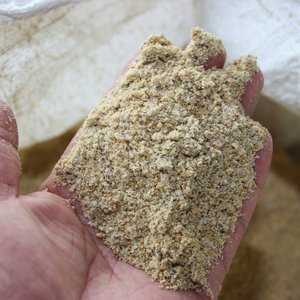WHEAT: Projected U.S. wheat supplies for 2012/13 are lowered 51 million bushels with reduced carryin and lower forecast winter wheat production. Beginning stocks are lowered 40 million bushels with a 10-million-bushel increase in food use and a 30-million-bushel increase in exports for 2011/12. The increase in 2011/12 food use reflects higher-than-expected flour milling during the January-March quarter as reported by the North American Millers’ Association. Exports are increased based on the strong pace of U.S. shipments during the final weeks of the old-crop marketing year.
U.S. all wheat production for 2012/13 is projected at 2,234 million bushels, down 11 million, with lower forecast winter wheat production and small reductions in forecast durum wheat production for Arizona and California. Winter wheat production is forecast 10 million bushels lower with reductions for Hard Red Winter (HRW) and Soft White Winter wheat. The largest production declines are in the HRW states of Nebraska and Colorado, but higher production for Oklahoma is partly offsetting. With reduced supplies and higher expected prices, feed and residual use is lowered 10 million bushels. Ending stocks for 2012/13 are projected 41 million bushels lower. The projected range for the 2012/13 season average farm price is raised 10 cents on both ends to $5.60 to $6.80 per bushel. This remains well below the record $7.25 per bushel projected for 2011/12.
Global wheat supplies for 2012/13 are lowered 7.0 million tons with beginning stocks lowered 1.5 million tons and world production expected down 5.5 million tons. Higher 2011/12 global consumption, fueled by increased global trade, reduces carryin for 2012/13. World production for 2012/13 is lowered reflecting reduced crop prospects in several exporting countries including Russia, EU-27, Turkey, and the United States. Russia production is reduced 3.0 million tons due to a continuation of spring dryness in key winter wheat producing areas and indications of crop development problems resulting from winter freeze damage. EU-27 production is reduced 1.0 million tons with reduced acreage in Germany, Poland, and Spain, only partly offset by higher expected yields in France and Bulgaria. Production is also lowered 1.0 million tons for Turkey as winter frost damage and disease problems reduce yields across the central growing areas on the Anatolia Plateau. Output is reduced 0.2 million tons for Syria as yield prospects decline for non-irrigated wheat in the country’s northeast.
Global wheat consumption for 2012/13 is lowered 4.6 million tons with reduced prospects for wheat feeding and food use. Wheat feeding is lowered for EU-27, Russia, and Turkey. Larger corn supplies and increased corn feeding more than offset the reduction for EU-27. Wheat food use is lowered for India, Bangladesh, and Indonesia. Increases in food use for Morocco and Turkey are partly offsetting. Global wheat exports are reduced 1.6 million tons with a 2.0-million-ton reduction for Russia and 0.3-million-ton reductions for both Argentina and Turkey. India exports are raised 1.0 million tons as market conditions improve the competitiveness of private exports. World ending stocks for 2012/13 are projected at 185.8 million tons, down 2.4 million from last month.
COARSE GRAINS: U.S. feed grain supplies for 2012/13 are virtually unchanged as adjustments to 2011/12 balance sheets are largely offsetting and projected 2012/13 production and use are unchanged on the month. Projected 2012/13 season average price ranges for corn, sorghum, barley, and oats are all unchanged.
Adjustments to corn usage for 2011/12 reflect the latest ethanol production and trade data. Corn used to produce ethanol in 2011/12 is projected 50 million bushels higher. Weekly ethanol production has increased since mid-April after gradually declining from the record levels of late December. The higher corn use projection assumes slightly lower ethanol production during the June-August quarter as compared with the same period last year. Corn exports are projected 50 million bushels lower as shipments and sales continue to fall off of the pace needed to reach last month’s projection. Tight domestic supplies and increased competition, especially from Brazil, are also expected to reduce U.S. export prospects during the summer months. Projected corn ending stocks for 2011/12 are unchanged, as is the 2011/12 season average farm price which remains at $5.95 to $6.25 per bushel.
Changes to the 2011/12 balance sheets for sorghum, barley, and oats are driven by the latest trade data and also mostly offsetting. Sorghum exports for 2011/12 are projected 10 million bushels lower, but offset by a 10-million-bushel increase in expected feed and residual use. Projected barley imports are raised 4 million bushels and exports are lowered 3 million bushels boosting ending stocks 7 million bushels. Oats ending stocks are projected 10 million bushels lower with projected imports lowered 15 million bushels and feed and residual use reduced 5 million bushels. Projected 2011/12 farm prices for all three feed grains are unchanged.
Global coarse grain supplies for 2012/13 are projected 4.8 million tons higher with increases in corn beginning stocks and production. Global corn beginning stocks are increased 1.6 million tons mostly reflecting higher 2011/12 production for Brazil and China. Brazil corn production is raised 2 million bushels for 2011/12. Despite lower reported area for the main season crop, the rapid expansion in area and nearly ideal weather for the second season (safrinha) crop is boosting Brazil’s corn production prospects to a record 69 million tons. Much of the expansion in safrinha corn has been in the Central West region, where corn is planted in January and a pronounced dry season typically begins by early May. This year’s rainy season extended through early June providing an additional 4 to 6 inches of beneficial rainfall for filling corn. China’s 2011/12 corn production is raised 1.0 million tons in line with recent revisions to official government estimates.
World corn production for 2012/13 is increased 4.2 million tons this month with increases in China, EU-27, and FSU-12. China production for 2012/13 is raised 2.0 million tons based on higher reported corn area as land planted to soybeans declines. EU-27 corn production is increased 1.1 million tons mostly on higher area and yields for Hungary. Production is up 0.8 million tons for Russia and 0.3 million tons for Belarus both on higher reported area. World barley production is lowered, however, with a 0.5-million-ton reduction for Turkey and 0.2-million-ton reduction for Syria.
Global 2012/13 coarse grain trade is projected higher this month on increased imports and exports of corn. Corn imports are raised for EU-27 and Indonesia. Corn exports are increased for Russia and Belarus, both reflecting higher expected production and supplies. Higher imports and production support increased corn feeding in EU-27. Higher beginning stocks and production in China boost prospects for feeding, but a partly offsetting reduction in industrial use limits the increase in corn consumption. Russia corn feeding is lowered 0.3 million tons reflecting slower expected year-to-year growth in feed grain consumption with rising feeding efficiencies in pork and poultry production. Global corn consumption is increased 2.4 million tons. Global corn ending stocks are projected 3.4 million tons higher. Of the increase, 2.0 million tons are for China and 1.0 million tons are for Brazil.
RICE: A reduced 2011/12 U.S. rice ending stocks forecast results in a tighter supply outlook for 2012/13. Beginning stocks for 2012/13 are reduced 4.5 million cwt to 29.5 million—down 39 percent from the previous year, and the lowest beginning stocks since 2004/05. Production and imports for 2012/13 are unchanged at 183.0 million cwt and 22.0 million, respectively. On the 2012/13 use side, domestic and residual use is lowered 1.0 million cwt to 122.0 million because of an expected decline in rice used in the brewing of beer—a trend observed in recent years. Monthly data recently released by the U.S. Department of the Treasury confirm the downward trend in 2011/12. Rice used in the brewing of beer through March is down 11 percent in 2011/12. The 2012/13 export forecast is lowered 2.0 million cwt to 87.0 million because of reduced exportable supplies—all in long-grain rice. U.S. 2012/13 ending stocks are projected at 25.5 million cwt, down 1.5 million from last month.
Smaller projected 2011/12 U.S. imports along with larger exports reduce 2011/12 ending stocks by 4.5 million cwt. U.S. rice imports for 2011/12 are projected at 20.0 million cwt, down 0.5 million from a month ago based on U.S. Bureau of the Census data through March. The pace of imports has slowed in recent months. Rice exports for 2011/12 are raised 4.0 million cwt to 101.0 million because of a significant pickup in sales and shipments in April and early May, and an increase in food-aid. Rough rice exports for 2011/12 are reduced 4.0 million cwt to 31.0 million based on Bureau of the Census data through April and export sales data through the end of May. Conversely, milled rice exports are raised 8 million cwt (rough-equivalent basis) to 70 million with large shipments to Asia.
Rough rice price forecasts for 2012/13 are unchanged from last month. The 2012/13 long-grain U.S. season average farm price is projected at $14.50 to $15.50 per cwt, combined medium- and short-grain rice price is $17.25 to $18.25 per cwt, and the all rice price is $15.30 to $16.30 per cwt. The midpoint of the 2011/12 all rice, long-grain, and combined medium- and short-grain prices are unchanged from a month ago, however, the price range is narrowed 10 cents on each end of the range for each.
Global 2012/13 rice supply and use is little changed from a month ago. Global rice production is projected at a record 466.5 million tons, up less than 100,000 tons from last month. Global 2012/13 exports are raised nearly 1.0 million tons mainly due to an increase for India, now forecast at 7.0 million, up 1.0 million from last month, but down 1.0 million from revised 2011/12. India’s 2011/12 exports are raised to a record 8.0 million tons. Import 2012/13 forecasts are raised for Iran and several African countries. Global consumption for 2012/13 is raised 1.0 million tons, primarily due to larger consumption for Iran, Vietnam, and several African countries. Global ending stocks for 2012/13 are projected at 104.2 million tons, down 0.7 million from last month, due primarily to a reduction for India.
OILSEEDS: This month’s U.S. soybean supply and use projections for 2012/13 include lower beginning and ending stocks and reduced use. Lower beginning stocks reflect increased export and crush projections for 2011/12. Soybean exports for 2011/12 are raised 20 million bushels to 1.335 billion bushels reflecting increased global import demand, led mainly by higher projected imports for China. Soybean crush is raised 15 million bushels mostly due to stronger domestic soybean meal use. Soybean ending stocks for 2011/12 are projected at 175 million bushels, down 35 million. With reduced supplies for 2012/13, soybean exports are projected at 1.485 billion bushels, down 20 million. Soybean crush is also projected lower due to reduced domestic soybean meal use. Ending stocks for 2012/13 are projected at 140 million bushels, down 5 million from last month.
Soybean, meal, and oil price projections for 2012/13 are unchanged this month. The U.S. season average soybean price is projected at $12.00 to $14.00 per bushel. Soybean meal and oil prices are projected at $335 to $365 per ton and 52.5 to 56.5 cents per pound, respectively.
Global oilseed production for 2012/13 is projected at 470.8 million tons, down 0.7 million from last month, mainly due to lower soybean and cottonseed production. China’s soybean production is reduced 0.5 million tons due to lower area as producers shift planting decisions toward corn. Brazil’s cottonseed production is also reduced due to lower area planted to cotton as world prices have declined in recent weeks. Other changes include reduced rapeseed production for EU-27, increased rapeseed production for Russia, increased sunflowerseed production for EU-27, and reduced cottonseed production for Australia and Egypt. Brazil’s 2011/12 soybean production is increased 0.5 million tons to 65.5 million while Argentina soybean production is reduced 1 million tons to 41.5 million.
SUGAR: Projected U.S. sugar supply for fiscal year 2012/13 is increased 341,000 short tons, raw value, compared with last month. The increase is due to higher beginning stocks and imports from Mexico. Mexico’s exports of sugar estimated for 2011/12 and projected for 2012/13 are increased due to higher production for both years. Production data for Mexico’s 2011/12 season are nearly complete, while the increase for 2012/13 is based on a favorable growing season since February.
LIVESTOCK, POULTRY, AND DAIRY: The forecast for total meat production in 2012 is raised from last month as higher pork and poultry production more than offsets lower beef production. Although remaining below last year, hatchery data are pointing towards smaller declines in eggs set and heavier bird weights are adding to production. Turkey production is also forecast slightly higher, based on recent production data. Pork production is raised on heavier expected carcass weights. USDA’s Quarterly Hogs and Pigs report will be released on June 29 and provide an indication of producer farrowing intentions for the remainder of the year. Beef production is reduced slightly as lower steer and heifer slaughter more than offsets higher dressed weights and higher cow slaughter. Small changes are made to 2013 beef and pork forecasts, largely reflecting higher expected carcass weights. Broiler and turkey production forecasts for 2013 are unchanged. Offsetting changes are made to 2012 quarterly egg production forecasts but the annual forecasts for 2012 and 2013 are unchanged from last month.
Forecasts for 2012 beef, broiler, and turkey trade are adjusted to reflect first-quarter data. Forecasts for 2013 are unchanged from last month. Pork exports for 2012 are raised from last month on the strength of trade data to date with a slight increase in forecast exports for 2013.
The cattle and turkey price forecasts for 2012 are unchanged from last month, but hog and broiler prices are reduced, reflecting larger production. Egg prices for 2012 are raised as recent prices have been stronger than expected. Prices for 2013 are unchanged.
The milk production forecast for 2012 is raised as cow numbers are expected to decline more slowly. The production forecast for 2013 is unchanged. Export forecasts are raised for both 2012 and 2013 on expected strength in cheese and nonfat dry milk (NDM) sales. Imports on a skim-solids basis are reduced slightly on lower expected imports of several dairy products.
NDM and whey prices for 2012 are forecast lower than last month on higher production and weaker demand. However, the cheese price is raised at the low end of the range on stronger demand and the butter price range is narrowed. The Class III price forecast is lowered from last month as the weaker whey price more than offsets the slightly higher forecast cheese price and the Class IV price is lowered on the weaker NDM price. The all milk price is forecast at $16.85 to $17.25 per cwt for 2011. Price forecasts for 2012 are unchanged from last month. The all milk price for 2013 remains unchanged from last month at $17.25 to $18.25 per cwt.
COTTON: This month’s U.S. cotton estimates for 2011/12 and 2012/13 show small revisions in trade, which leave 2012/13 ending stocks unchanged from last month. The 2012/13 production estimate of 17.0 million bales also is unchanged, pending further information about planted area and weather developments. Exports for 2011/12 are raised by 200,000 bales, reflecting recent strong sales and shipments, while exports for 2012/13 are reduced by 200,000 bales, due to lower expected foreign import demand. Domestic mill use is unchanged. The projected range for the 2012/13 season average price received by producers is 60 to 80 cents per pound, 5 cents below last month on each end.
The world 2012/13 cotton projections include lower production, consumption, and trade relative to last month, with beginning and ending stocks projected slightly higher. World production is down 1.4 million bales, as the southern hemisphere producers of Brazil, Australia, and Argentina are expected to make further cuts in area in response to the recent sharp drop in cotton prices. World consumption is reduced about 1.0 million bales, as decreases for China and Thailand are partially offset by an increase for India. With world prices falling, China’s reserve floor price will make it increasingly difficult for mills there to be competitive producers of yarn. China’s 2012/13 imports also are reduced due mainly to larger estimated beginning stocks, accounting for most of the almost 700,000-bale reduction in world trade. World ending stocks projected at a record 74.5 million bales are raised 1 percent from last month, with China expected to hold 42 percent of the total.
The most significant revisions to the world 2011/12 cotton estimates include an increase of nearly 1.8 million bales in China’s imports, reflecting the continued strong pace of deliveries, and corresponding increases in exports for India, Brazil, Australia, the United States, and Malaysia. India’s balance sheet also is revised to reflect recent indications of higher consumption; a residual has been added for each year beginning in 2006/07 to offset a deficit in stocks that would otherwise result from the available statistics for production, consumption, and trade.







